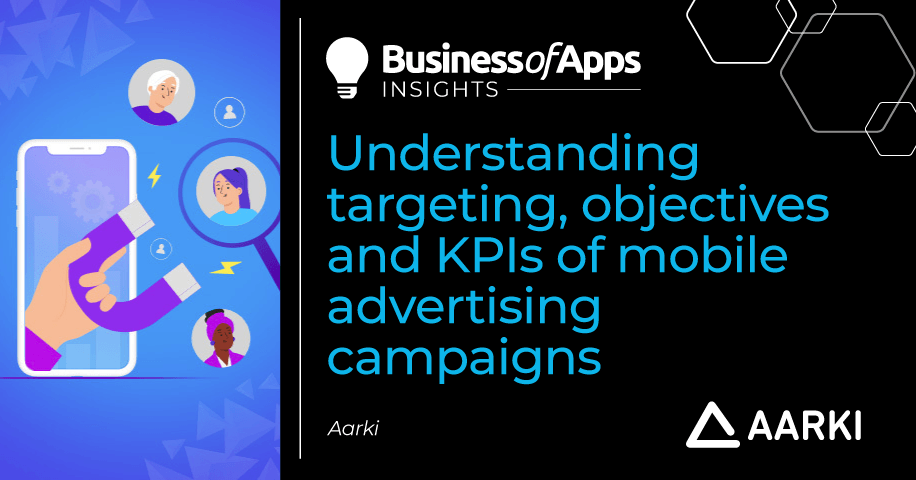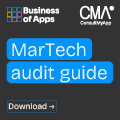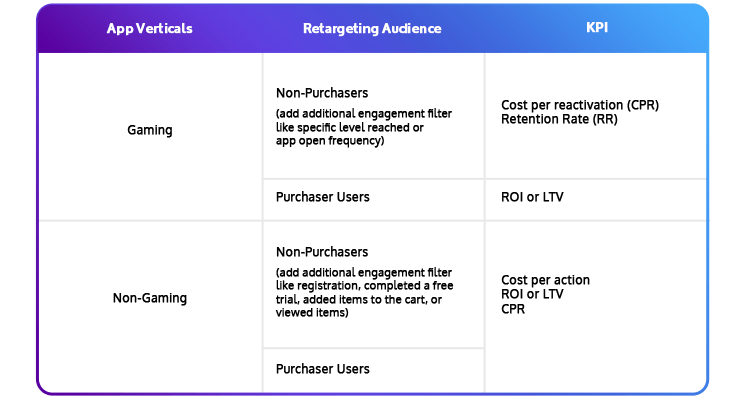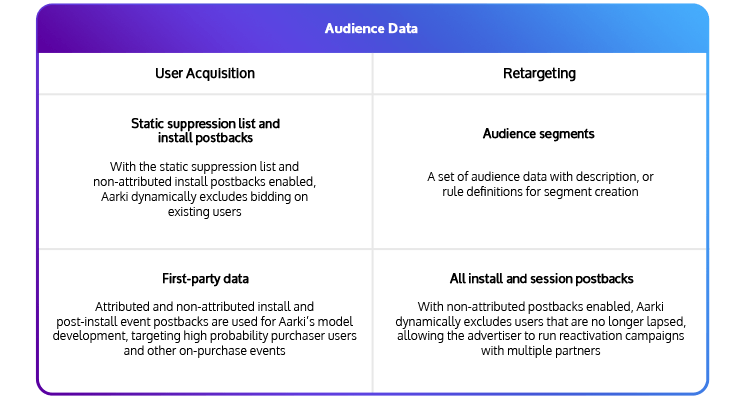The mobile app world is fiercely competitive, with hundreds and thousands of app publishers fighting over the most valuable users. As a mobile marketer, the best way to attract high-quality users is through mobile programmatic. Why? The answer is simple – it’s the most convenient and cost-effective method for you to reach the right users with the right ad creative at just the right time.
Based on your campaign objectives, you can select from two mobile programmatic strategies: user acquisition or retargeting. To help you make data-driven choices, we explore the details of each of these two strategies below.
Objectives and KPIs of a user acquisition campaign
User acquisition campaigns aim to grow your high lifetime value (LTV) user base. This is also the best strategy to increase your brand awareness.
The objectives and KPIs of a user acquisition campaign can vary depending on your app’s marketing lifecycle stage. Is your app a new app or an established app?
If your app is new, your focus should be to acquire users at a low price. In this lifecycle stage, the goal is to increase brand awareness and fight for your app’s visibility in the market. The focus of your user acquisition campaign should be to drive traffic and downloads. The metrics you should look out for are low cost-per-mille (CPM), low cost per install (CPI), and high install volume.
Top-funnel metrics
- Cost-per-mille (CPM) – Also known as “cost per thousand impressions,” this is a pricing model wherein the advertising cost depends on the number of impressions served. Read our article where we talk about CPM in more detail.
- Cost per install (CPI) – Evaluate this by looking at your spend divided by the number of installs you have achieved. This pricing model charges per app installation.
- Install volume – This metric is the volume of installs your campaign generates.
The next step after widening your app’s user base, is improving the quality of those users. Quality users are those who bring in revenue to your app, allowing you to fund more marketing activities. The KPIs for this stage should focus on post-install events such as retention, LTV, and return on ad spend (ROAS).
Bottom-funnel metrics
- Retention – Evaluate this by looking at the proportion of repeat users divided by the total number of users. Maintaining high-quality and engaged users contributes to the success and revenue of your app.
- Lifetime value (LTV) – LTV is a way of calculating the value of a new user. This predicts the worth of your user to your app, over their whole relationship with your app. Our recent article will help you understand the importance of LTV.
- Return on ad spend (ROAS) – This is the amount of revenue you earn for every dollar spent on a campaign.
Objectives and KPIs of a retargeting campaign
A retargeting strategy is focused on re-engaging known high LTV users. It acts as a defensive strategy to prevent users from churning, by identifying users at risk of lapsing through measuring engagement rates, such as retention and purchase.
Retargeting campaign KPIs will vary based on two considerations: the users you are targeting and your app vertical.
For most apps, we can categorize a user as either a purchaser or a non-purchaser. However, gaming apps should evaluate their users differently. For non-purchasers, gaming apps should focus on reactivating the users cheaply while reducing their churn rate and increasing user engagement that may lead to a purchase over time. Purchaser users, on the other hand, should be reactivated to increase their lifetime value further. As they are already proven to be invested in your app, they are more likely to repurchase and should be mainly evaluated based on return on investment (ROI).
Time for a MarTech health check
Is your MarTech stack fueling growth or wasting budget? Spot the issues and fix them fast with this free guide from the experts at ConsultMyApp.
Download nowFor non-gaming apps, especially for subscription-based apps, cost per action is the best KPI. The specific user action will vary for a purchaser and non-purchaser user. Apps with multiple purchase actions, such as e-Commerce apps, can still focus on ROI.
Gaming vs non-gaming audiences
Source: Aarki
If you are still in the early stage of testing your retargeting approach and haven’t figured out its effectiveness for your app or your targeting strategy, then running an incremental lift test is a must. You want to be able to demonstrate an incremental lift for each of the KPI metrics mentioned above. When measuring ROI, you should also look at your incremental revenue.
Targeting for each campaign
Knowing your app’s user base is critical for success with any type of campaign. User acquisition campaigns target new users or users that have never downloaded your app before. Retargeting, on the other hand, targets inactive users who installed your app but no longer use it.
The below table shows how Aarki uses audience data for UA and RT campaigns.
User acquisition vs retargeting audience data
User Acquisition and Retargeting should go hand in hand to create positive user experiences and create a lift in campaign performance. Once you have established your user base through User Acquisition, the best strategy is to then encourage users to return to your app and remain engaged through Retargeting. Ultimately, it’s all about balance.
To know more about how Aarki can help you catapult your next app marketing campaign, shoot us a message here.













